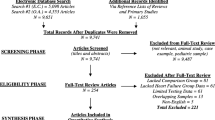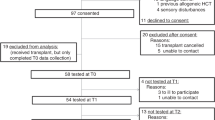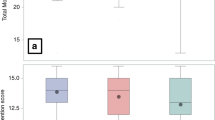Abstract
Clinical psychologists working in medical settings are increasingly broadening their services to include consultation to cardiac transplant programs. These services may include the neuropsychological assessment of end-stage cardiac patients, who as a group are at risk for neuropsychological impairment. This paper provides descriptive neuropsychological data partitioned by age, race, and educational level from a sample of 760 end-stage cardiac patients who underwent neuropsychological testing as a routine part of a comprehensive heart transplant candidacy evaluation. Between one-fourth and one-third of the sample obtained scores that fell two standard deviations or greater below the expected performance (using available norms) on 11 of the 19 test variables. Performance difficulties were most commonly found on tests of manual speed, psychomotor speed, mental speed, and verbal learning and memory. This descriptive report improves upon previously published papers that were limited by relatively small sample size and failure to partition test results across important demographic characteristics.
Similar content being viewed by others
REFERENCES
Abikoff, H., Alvir, J., Hong, G., & Sukoff, R. (1987). Logical memory subtest of the Wechsler Memory Scale: Age and education norms and alternate-form reliability of two scoring systems. Journal of Clinical and Experimental Neuropsychology, 9, 435–448.
Adrian, J., Crankshaw, D. P., Tiller, J. W., & Stanley, R. O. (1988). Affective, cognitive and subjective changes in patients undergoing cardiac surgery—a preliminary report. Anaesthesia & Intensive Care, 16, 144–149.
Barclay, L. L., Weiss, E. M., Mattis, S., Bond, O., & Blass, J. P. (1988). Unrecognized cognitive impairment in cardiac rehabilitation patients. Journal of the American Geriatrics Society, 36, 22–28.
Benton, A. L., & Hamsher, K. (1983). Multilingual Aphasia Examination. Iowa City: AJA Associates.
Bornstein, R. A. (1985). Normative data on selected neuropsychological measures from a nonclinical sample. Journal of Clinical Psychology, 41, 651–659.
Bornstein, R. A., & Brown, G. G. (1991). Neurobehavioral aspects of cerebrovascular disease. New York: Oxford University Press.
Bornstein, R. A., Starling, R. C., Myerowitz, P. D., & Haas, G. J. (1995). Neuropsychological function in patients with end-stage heart failure before and after cardiac transplantation. Acta Neurologica Scandinavica, 91, 260–265.
Buschke, H. (1973). Selective reminding for analysis of memory and learning. Journal of Verbal Learning and Verbal Behavior, 12, 543–550.
Freeman, A. M., Watts, D., & Kari, R. (1984). Evaluation of cardiac transplant candidates: preliminary observations. Psychosomatics, 25, 197–199.
Heaton, R. K., Grant, I., & Matthews, C. G. (1991). Comprehensive norms for an expanded Halstead-Reitan battery. Odessa; FL: Psychological Assessment Resorces.
Heaton, R. K., & Pendleton, M. G. (1981). Use of Neuropsychological tests to predict adult patients' everyday functioning. Journal of Consulting and Clinical Psychology, 49, 807–821.
Hecker, J. E., Norvell, N., & Hills, H. (1989). Psychologic assessment of candidates for heart transplantation: Toward a normative data base. Journal of Heart Transplantation, 8, 171–176.
Holmen, K., Ericsson, K., Andersson, L., & Winblad, B. (1993). ADL capacity and loneliness among elderly persons with cognitive impairment. Scandinavian Journal of Primary Health Care, 11, 56–60.
Hosenpud, J. D., Novick, R. J., Breen, T. J., & Daily, O. P. (1994). The registry of the international society for heart and lung transplantation: Eleventh official report-1994. Journal of Heart and Lung Transplantation, 13, 561–570
Ichibangase, A., Nishikawa, M., Iwasaka, T., Kobayashi, T., & Inada, M. (1990). Relation between thyroid and cardiac functions and the geriatric rating scale. Acta Neurologica Scandinavica, 81, 491–498.
Kaplan, E., Goodglass, H., & Weintraub, S. (1983). Boston Naming Test (Revised 60 item version). Philadelphia: Lea and Febiger.
Leier, C. V. (1988). Regional blood flow responses to vasodilators and inotropes in congestive heart failure. American Journal of Cardiology, 62, 86E–93E.
Lishman, W. A. (1987). Organic psychiatry. The psychological consequences of cerebral disorder (2nd Ed.) Oxford: Blackwell Scientific.
Matthews, C. G., & Klove, H. (1964). Instruction Manual for the Adult Neuropsychology Test Battery. Madison: University of Wisconsin Medical School.
McSweeny, A. J., Grant, I., Heaton, R. K., Prigatano, G. P., & Adams, K. M. (1985). Relationship of neuropsychological status to everyday functioning in healthy and chronically ill persons. Journal of Clinical and Experimental Neuropsychology, 7, 281–291.
Miller, L. W., Kubo, S. H., Young, J. B., Stevenson, L. W., Loh, E., & Costanzo, M. R. (1995). Report of the consensus conference on candidate selection for heart transplantation—1993. Journal of Heart & Lung Transplantation, 14, 562–571.
Nussbaum, P. D., & Goldstein, G. (1992). Neuropsychological sequelae of heart transplantation: A preliminary review. Clinical Psychology Review, 12, 475–483.
Reitan, R. M., & Davison, L. A. (1974). Clinical neuropsychology: Current status and applications. Washington, D. C. Winston.
Richardson, E. D., Nadler, J. D., & Malloy, P. F. (1995). Neuropsychological prediction of performance measures of daily living skills in geriatric patients. Neuropsychology, 9, 565–572.
Riether, A. M., Smith, S. L., Lewison, B. J., Cotsonis, G. A., & Epstein, C. M. (1992). Quality-of-life changes and psychiatric and neurocognitive outcome after heart and liver transplantation. Transplantation, 54, 444–450.
Robinson, M., Blumenthal, J. A., Burker, E. J., Hlatky, M., & Reves, J. G. (1990). Coronary artery bypass grafting and cognitive function: A review. Journal of Cardiopulmonary Rehabilitation, 10, 180–189.
Rozzini, R., Frisoni, G. B., Bianchetti, A., Zane, O., & Trabucchi, M. (1993). Physical performance test and activities of daily living scales in the assessment of health status in elderly people. Journal of the American Geriatrics Society, 41, 1109–1113.
Ruff, M. R., Light, R. H., & Quayhagen, M. (1988). Selective Reminding Test: A normative study of verbal learning in adults. Journal of Clinical and Experimental Neuropsychology, 11, 539–550.
Russell, E. W. (1975). A multiple scoring method for the assessment of complex memory functions. Journal of Consulting and Clinical Psychology, 43, 800–809.
Schall, R. R., Petrucci, R. J., Brozena, S. C., Cavarocchi, N. C., & Jessup, M. (1989). Cognitive function in patients with symptomatic dilated cardiomyopathy before and after cardiac transplantation. Journal of the American College of Cardiology, 14, 1666–1672.
Smith, A. (1973). Symbol Digit Modalities Test. Los Angeles: Western Psychological Services.
Spreen, O., & Strauss, E., (1991). Wechsler Memory Scale associative learning norms. In E. Strauss & O. Spreen, (Eds.), A compendium of neuropsychological tests (p. 201). New York: Oxford University Press.
Strauss, B., Thormann, T., Strenge, H., Biernath, E., Foerst, U., Stauch, C., Torp, U., Bernhard, A., & Speidel, H. (1992). Psychosocial, neuropsychological and neurological status in a sample of heart transplant recipients. Quality of Life Research, 1, 119–128.
Trahan, D. E., Quintana, J., Willingham, A. L., & Goothe, K. E. (1988). The visual reproduction subtest: Standardization and clinical validation of a delayed recall procedure. Archives of Clinical Neuropsychology, 2, 29–39.
Trenerry, M. R., Crosson, B., DeBoe, J., & Leber, W. R. (1989). Stroop Neuropsychological Screening Test manual. Odessa, FL: Psychological Assessment Resources.
Wechsler, D. (1955). Wechsler Adult Intelligence Scale. New York: The Psychological Corporation.
Zachary, R. A. (1986). Shipley Institute of Living Scale. Revised manual. Los Angeles: Western Psychological Services.
Author information
Authors and Affiliations
Rights and permissions
About this article
Cite this article
Putzke, J.D., Williams, M.A., Millsaps, C.L. et al. Heart Transplant Candidates: A Neuropsychological Descriptive Database. Journal of Clinical Psychology in Medical Settings 4, 343–355 (1997). https://doi.org/10.1023/A:1026293517271
Issue Date:
DOI: https://doi.org/10.1023/A:1026293517271




